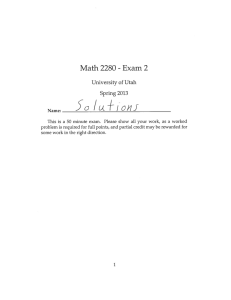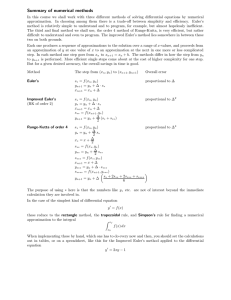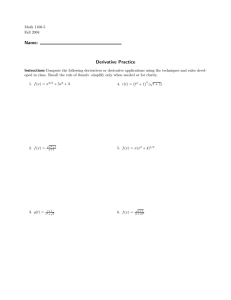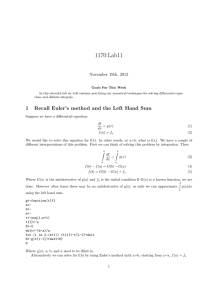1170:Lab9 November 5th, 2013
advertisement
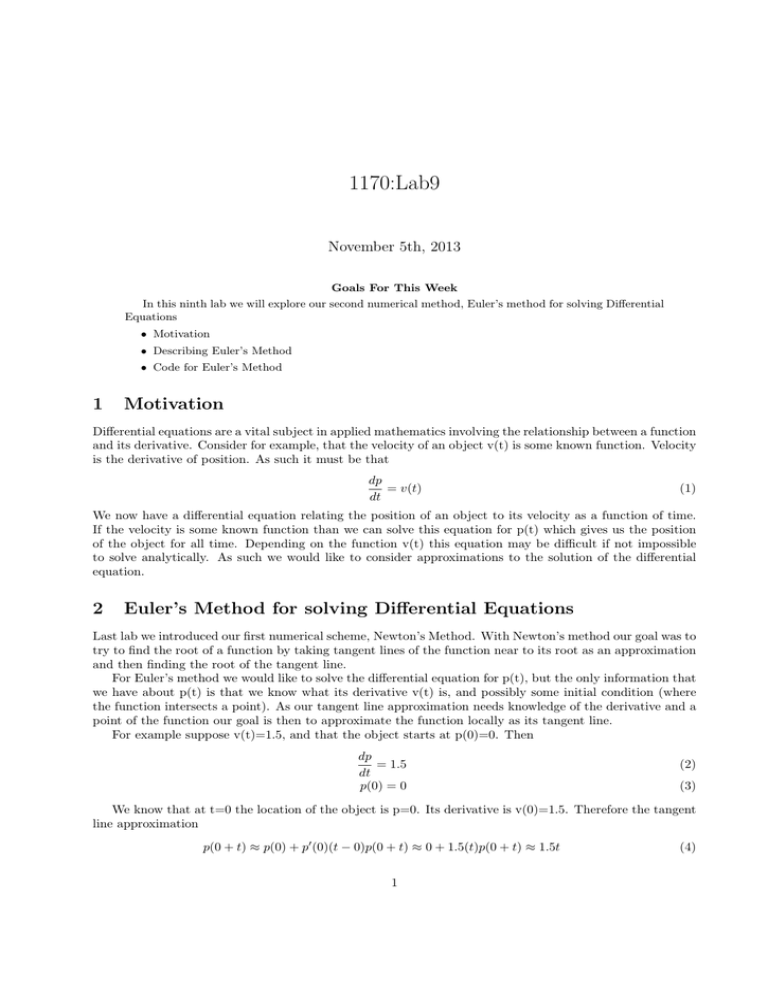
1170:Lab9
November 5th, 2013
Goals For This Week
In this ninth lab we will explore our second numerical method, Euler’s method for solving Differential
Equations
• Motivation
• Describing Euler’s Method
• Code for Euler’s Method
1
Motivation
Differential equations are a vital subject in applied mathematics involving the relationship between a function
and its derivative. Consider for example, that the velocity of an object v(t) is some known function. Velocity
is the derivative of position. As such it must be that
dp
= v(t)
dt
(1)
We now have a differential equation relating the position of an object to its velocity as a function of time.
If the velocity is some known function than we can solve this equation for p(t) which gives us the position
of the object for all time. Depending on the function v(t) this equation may be difficult if not impossible
to solve analytically. As such we would like to consider approximations to the solution of the differential
equation.
2
Euler’s Method for solving Differential Equations
Last lab we introduced our first numerical scheme, Newton’s Method. With Newton’s method our goal was to
try to find the root of a function by taking tangent lines of the function near to its root as an approximation
and then finding the root of the tangent line.
For Euler’s method we would like to solve the differential equation for p(t), but the only information that
we have about p(t) is that we know what its derivative v(t) is, and possibly some initial condition (where
the function intersects a point). As our tangent line approximation needs knowledge of the derivative and a
point of the function our goal is then to approximate the function locally as its tangent line.
For example suppose v(t)=1.5, and that the object starts at p(0)=0. Then
dp
= 1.5
dt
p(0) = 0
(2)
(3)
We know that at t=0 the location of the object is p=0. Its derivative is v(0)=1.5. Therefore the tangent
line approximation
p(0 + t) ≈ p(0) + p0 (0)(t − 0)p(0 + t) ≈ 0 + 1.5(t)p(0 + t) ≈ 1.5t
1
(4)
From earlier however we know that a tangent line approximation is only a good approximation of a function
very close to the point. As such we are going to define t = δt where δt is some small number. Then
p(0 + δt) ≈ 1.5δt
(5)
p(δt) ≈ 1.5δt
(6)
We now have an approximation for p(t) up from time t=0 up to time t = δt. We now want to do the
same thing again, but this time using the tangent line at (δt, p(δt))
p(δt + δt) ≈ p(δt) + p0 (δt)(2δt − δt)
(7)
p(2δt) ≈ (1.5δt) + v(δt)(δt)
(8)
p(2δt) ≈ 1.5δt + 1.5(δt)
p(2δt) ≈ 3δt
(9)
(10)
We will than continue in this manner until we reach the time that we want to stop at.
To ground this example let us let δt = 1
Then:
3
p(1) = 1.5(1) = 1.5
(11)
p(2) = 3(1) = 3
(12)
R Code for Euler’s Method
First we are going to define some variables for the equation:
df
= g(t)
dt
f (a) = f a(initialvalue)
(13)
(14)
We will call:
a = the left endpoint, or our initial value
b = the right endpoint, or out terminal value
n = the number of time steps we want to make
delt = timestep δt
t = a sequence of the time values
f = a sequence of the function values
g = the derivative function
Consider the following differential equation which we want to solve over the interval t=(0,10)
df
= et
dt
f (0) = 0
Then:
a=0
b = 10
n = 10
delt = (b-a)/n
t = seq(1,n) (preallocate the time values)
2
(15)
(16)
f = seq(1,n) (preallocate the f values)
g = et
We will now iterate the code in a for loop:
g<-function(t){exp(t)}
a<-0
b<-10
n<-10
t<-seq(1,n)
f<-seq(1,n)
t[1]<-0
f[1]<-0
delt<-(b-a)/n
for (i in 2:(n+1)) {t[i]<-t[i-1]+delt
f[i]<-g(t[i-1])*delt+f[i-1]}
plot(t,f,type=’l’)
Now lets see how it compares to the solution f (x) = ex − 1.
x<-seq(0,10,.01)
sol<-function(x){exp(x)-1}
lines(x,sol(x))
Change n to be 100 and rerun the code. Does this give us a better approximation of the solution?
4
Assignment for this week
Consider the differential equation
df
dt
= esin(t) , with initial condition f(0)=0.
1. Write your own Euler’s Method code to approximate the solution to this differential equation.
2. Plot the resulting solutions for n=10, n=100, and n=1000
3. What would cause Euler’s method to perform poorly. What types of derivative functions would cause
there to be large error. Suggest an improvement that could be made to Euler’s method that would
help to alleviate this problem.
3

